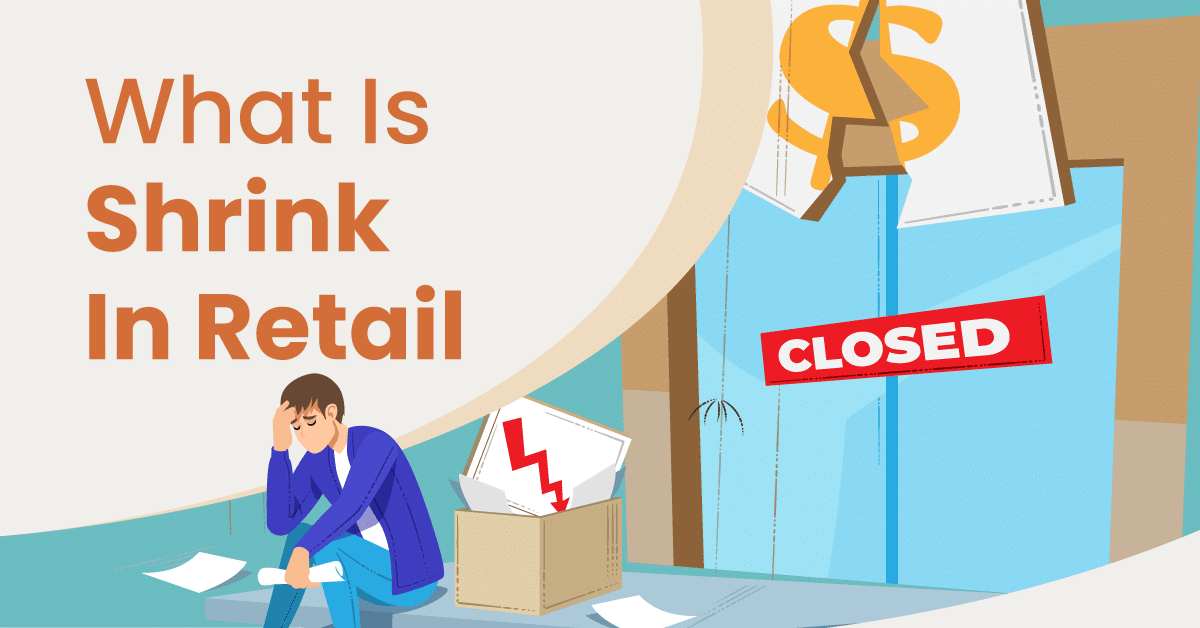
In retail, shrink refers to the loss of inventory or assets. This phenomenon can happen due to various factors, such as theft, errors, and damages.
Shrink is a significant concern for retailers worldwide, directly impacting their profitability and overall business operations. And the trend doesn’t seem to be reversing anytime soon. For example, harware giant Lowe’s has reported over $1 billion a year in shrink. Similarly, Target saw as much as $753 million worth of retail shrink in 2022.
This article delves into shrink, its causes, consequences, and how to prevent shrinkage in retail.
Key Takeaways: Shrink In Retail and Preventing shrinkage
- Shrinkage Overview: Retail shrinkage, encompassing inventory loss due to theft, errors, and damages, poses a significant challenge for retailers globally, impacting profitability and operations.
- Calculating Shrink: Retailers measure shrink as a percentage of total sales, aiming for a figure ideally below 2%, calculated by dividing total losses by total sales.
- Causes of Shrinkage: Common causes include shoplifting, employee theft, administrative errors, vendor fraud, and damages/spoilage, necessitating comprehensive prevention strategies.
- Prevention Strategies: Effective measures include inventory management software, RFID tracking, employee training, standard cash handling procedures, and more.
Calculating Shrink in Retail
Retailers measure shrink as a percentage of a retailer’s total sales. Calculate your shrinkage by dividing your total losses by total sales. This equation will yield your percentage of retail shrinkage.
Ideally (but realistically), you want this number to be below 2%.
Retail shrink % = total losses (÷) total sales
5 Causes of Retail Shrinkage
Retailers may deal with one or many causes of shrinkage. Here are the most prevalent issues to think about:
1. Shoplifting
One of the most common causes of shrinkage is shoplifting, where customers steal merchandise without paying for it. Shoplifters employ various tactics to conceal their actions, making it challenging for retailers to detect and prevent these losses.
Modern asset security technology, including the increasing use of RFID, has made it easier for retailers to prevent shoplifting and/or catch shoplifters.
2. Employee Theft
Unfortunately, not all shrinkage comes from external sources. Employee theft is another significant contributor.
Employees may steal merchandise, manipulate inventory records, or provide unauthorized discounts to friends and family.
3. Administrative Errors
Clerical mistakes, such as inaccurate inventory counts or pricing errors, can result in shrinkage. These errors may occur during data entry, stock replenishment, or when merchandise gets moved within the store.
Using outdated inventory management systems and manual inventory reconciliation often worsens these matters.
4. Vendor Fraud
Sometimes, suppliers or vendors contribute to shrinkage by misrepresenting products or quantities delivered. Vendors may provide fewer items than invoiced, causing inventory discrepancies. They may also send damaged or expired products, leading to unsellable goods that retailers must write off.
Some vendors might even supply counterfeit or subpar merchandise, which retailers can lead to customer complaints and returns.
5. Damages and Spoilage
Merchandise can get damaged during transportation, while on the sales floor, or even due to customer mishandling. Perishable items may also spoil, leading to financial losses.
This factor can significantly impact profitability for convenience stores, groceries, and even beer distributors.
How To Prevent Shrinkage In Retail: 10 Effective Ways
Businesses employ various strategies and technologies to address shrink in retail. Retailers should invest in security systems, surveillance cameras, and trained personnel to deter shoplifting and employee theft.
1. Inventory Management Software
Inventory management software reduces retail shrinkage by providing greater visibility and control over a store’s inventory. Such software more readily identifies shrinkage patterns and trends, enabling retailers to implement targeted strategies for loss prevention.
These tools minimize the chances of theft or errors going unnoticed. Many inventory management solutions offer demand forecasting, inventory planning and optimization tools, helping retailers maintain appropriate inventory levels and reducing overstock situations.
Finally, some integrations with security systems will trigger alerts and notifications for suspicious activities or inventory movement.

Learn how to manage your inventory effectively with this free eGuide.
2. RFID Tracking
RFID (Radio-Frequency Identification) tags, attached to individual products or packaging, allow for real-time store tracking and merchandise monitoring. This technology enables retailers to conduct automated, highly accurate inventory counts, reducing the likelihood of discrepancies and errors that can lead to shrinkage. Studies show a minimum of 25% average improvement in inventory accuracy with the use of RFID.
RFID can also trigger security apparatuses when tagged items leave the store without being purchased.
3. Establish Standard Operating Procedures for Cash
Implementing a standard operating procedure (SOP) for cash handling is crucial for minimizing retail shrinkage in stores. Retailers should establish clear guidelines for cash handling tasks such as cash register reconciliation, depositing cash in safes at regular intervals, and conducting frequent register audits.
Assign specific responsibilities to trained employees, enforcing dual control measures for cash handling, and conducting regular training sessions on cash handling procedures enhance accountability and reduce the risk of internal theft.
Implementing SOPs also involves regularly reviewing and updating procedures to adapt to evolving risks and technologies, ensuring a robust defense against retail shrinkage.
4. Vendor Audits
Enhancing transparency in the supply chain helps prevent discrepancies and fraud related to incoming inventory. Regularly auditing vendors ensures that the merchandise received matches the original order, reducing vendor-related shrinkage.
When dealing with supplers, set up a scheduled cadence to ensure that you do your due diligence and that your they provide precisely what they agreed to in your contracts. Another option is to negotiate a swell allowance with suppliers. Swell allowance is a percentage of the goods’ purchase price subtracted from the invoice to reimburse the retailer for unsellable items.
5. Data Analytics
Data analytics enable retailers to analyze historical shrinkage data and identify patterns. This insight helps them understand where and when losses are most likely.
Predictive analytics forecasts potential shrinkage risks, allowing retailers to allocate resources and implement preventive measures proactively.
In addition, real-time data analysis triggers alerts for suspicious activities, such as unusual inventory or transaction anomalies, aiding in immediate loss prevention.
6. Improved Store Layout
An improved store layout can reduce retail shrinkage by enhancing visibility and control over the retail environment. Strategically place high-risk or high-value items near checkout counters or within staff sightlines to make it harder for shoplifters to operate discreetly.
Well-organized retail floor plans reduce clutter and make it easier for employees to spot misplaced or missing items. Smart floor designs with open sightlines and strategically placed displays and mirrors can deter shoplifters by minimizing blind spots.
7. Locking Up Sensitive Areas
Locking up sensitive retail store areas, such as stockrooms, cash offices, and high-value merchandise sections, will significantly reduce retail theft by limiting unauthorized access. This restricts the opportunity for both employees and customers to steal items or discreetly tamper with inventory records.
Additionally, it acts as a deterrent, making it more challenging for potential thieves to execute their plans and ultimately contributing to a safer and more secure retail environment.
8. Employee Training
Employee training reduces retail shrinkage by creating a more vigilant and knowledgeable workforce. Educating employees about the various types of shrinkage, including theft and errors, raises their awareness of potential risks.
Emphasize the importance of accurate inventory management, reducing errors and miscounts that can lead to shrinkage. Proper training equips staff members with effective loss-prevention strategies. Staff members will recognize suspicious behavior among customers or colleagues and adhere to security protocols.

Foster a culture of accountability where employees understand the impact of shrinkage on the company’s profitability. Encourage your staff to participate actively in prevention.
9. Surveillance Cameras
Installing obvious and visible security cameras in a retail business is essential for thwarting theft and ensuring store safety. Strategically placing cameras at entrance points, aisles, and high-risk areas deters potential thieves and creates a perception of surveillance.
Clear signage indicating the presence of cameras reinforces this deterrent effect. Additionally, employing modern surveillance systems with high-definition cameras and remote monitoring capabilities enhances security measures.
Regular maintenance and visible placement of cameras signal a proactive stance against theft, boosting customer confidence and minimizing retail shrinkage.
10. Return Policies That Work for You and Your Customer
Craft a clear return policy with defined eligibility criteria, timeframes, and receipt requirements. Implement limitations on returns for opened or used items, and consider restocking fees.
Regularly monitor return transactions for anomalies and analyze patterns to detect and deter fraudulent activities, minimizing the risk of retail shrinkage and theft.
Be sure to include:
- Clear Guidelines: Establish transparent return policies outlining eligibility criteria, timeframes, and acceptable conditions for returns. Clear communication reduces ambiguity and deters fraudulent returns.
- Receipt Requirements: Require proof of purchase such as receipts or order confirmations for all returns. This helps verify the legitimacy of returns and prevents fraudulent activities like “return fraud” or “wardrobing.”
- Limitations and Restocking Fees: Set reasonable limitations on returns, including restrictions on opened or used items. Consider implementing restocking fees for returned merchandise to offset potential losses and discourage frivolous returns.
- Monitoring and Analysis: Regularly monitor return transactions and analyze patterns to identify anomalies or suspicious behavior. Utilize technology such your point of sale system to track returns and flag unusual activity, enabling timely intervention to prevent shrinkage and retail fraud.

4 Consequences of Shrink in Retail
Shrinkage has far-reaching consequences for retailers, affecting their bottom line and overall operations:
Financial Impact
Shrinkage represents a direct loss of inventory or revenue, which can erode a retailer’s gross profit margin. The retailer purchases products without any corresponding revenue when items are stolen or lost. Of course, this contributes to reduced overall profitability.
Pricing and Margins
Retailers may increase product prices to compensate for shrinkage. These measures can make them less competitive in the market, and customers are more likely to look elsewhere and purchase similar products from competitors.
Conversely, if the retailer decides to reduce profit margins, it could potentially damage its bottom line and cash flow.
Irregularities and Stockouts
Retail shrinkage can lead to stockouts when inventory losses are not promptly identified and replenished. When merchandise gets stolen, damaged, or unaccounted for, it creates a discrepancy between recorded inventory levels and actual on-hand stock.
If retailers do not adjust their inventory ordering and restocking processes to account for these losses, they may inadvertently under-order, leading to insufficient stock levels. These irregularities, in turn, can result in stockouts, leaving customers unable to purchase desired items.
Customer Experience
Retailing environments and experiential shopping are more critical than ever to business success. Many customers discover new stores and products through local inventory searches and eCommerce platforms.
Empty shelves, inaccurate product information, and out-of-stock items will frustrate customers, potentially driving them to competitors.
KORONA POS has been a huge game changer for my overall profitability. Implementation was seamless and painless! The support staff is great and always ready to help. Had I known it would be this easy, I would have made the switch sooner!
-Kristen L.
Conclusion: Secure Your Inventory with KORONA POS
In the modern era, the best retail point of sale solutions play a crucial role in reducing retail shrinkage. KORONA POS provides detailed end of day reports showing all actions taken by cashiers on the floor. Our dashboard is entirely customizable to taper access according to staff needs and clearance.
In addition, real-time inventory tracking and RFID mitigate the risk of errors and discrepancies immensely. KORONA POS generates detailed sales reports, allowing retailers to identify irregularities or suspicious activities, aiding in the early detection and prevention of theft. Our software eliminates blind spots and errors across all aspects of retail.
Click the button below to learn more about KORONA POS and how we can help take your business to the next level.
FAQs: What Is Shrink in Retail
In retail, the term “shrink,” or “shrinkage,” refers to the loss of inventory or revenue due to theft, fraud, damage, errors, or other causes. These factors result in a discrepancy between the recorded and actual inventory on hand. Retailers often closely monitor and implement strategies to reduce shrinkage to protect their profitability and assets.
An example of shrinkage in retail is when a store experiences theft of merchandise by customers or employees. For instance, if a cashier intentionally under-rings items to give unauthorized discounts to friends, it results in a loss of revenue and merchandise for the store. Another example of shrinkage is receiving damaged merchandise from a wholesaler.
To effectively prevent retail shrinkage, retailers should adopt a multifaceted approach. This includes implementing robust security measures such as surveillance cameras and alarms, fostering a culture of integrity among employees through training and awareness programs, and implementing stringent inventory control practices. Conduct regular audits and use data analysis to identify and address discrepancies promptly. Controlling access to storage areas and high-value items helps reduce internal theft opportunities, contributing to a comprehensive strategy to minimize shrinkage.













